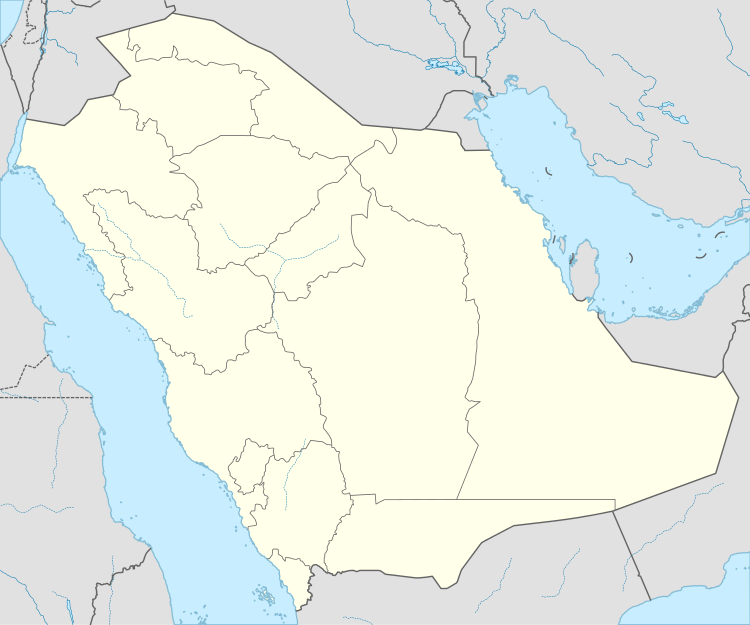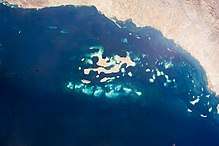Farasan Islands


The Farasan Islands (Arabic: جزر فرسان; transliterated: Juzur Farasān) are a large coral-island group in the Red Sea, belonging to Saudi Arabia. The islands are located some 40 km offshore from Jizan, in the far southwestern part of the country, at 16°48′N 41°54′E / 16.800°N 41.900°ECoordinates: 16°48′N 41°54′E / 16.800°N 41.900°E. The largest island of the archipelago is Farasan Island; others include Sajid Island and Zufaf Island.
Climate
The climate in the Farasan Archipelago is characterised by a long hot season (April- October) and a short mild one (November -March). In the long dry period high temperatures are usually dominant. The mean annual temperature is 30 C. Furthermore, the mean relative humidity in winter ranges from 70% to 80% and in summer between 65% and 78%. The highest rainfall occurs in April and the precipitation is generally unpredictable in the southern part of Red sea.[1]
| Climate data for Farasan Island [2] | |||||||||||||
|---|---|---|---|---|---|---|---|---|---|---|---|---|---|
| Month | Jan | Feb | Mar | Apr | May | Jun | Jul | Aug | Sep | Oct | Nov | Dec | Year |
| Average high °C (°F) | 30 (86) |
31 (88) |
33 (91) |
35 (95) |
37 (99) |
39 (102) |
39 (102) |
39 (102) |
38 (100) |
36 (97) |
34 (93) |
31 (88) |
35 (95) |
| Daily mean °C (°F) | 25.5 (77.9) |
26.5 (79.7) |
28 (82) |
30 (86) |
32 (90) |
34 (93) |
34.5 (94.1) |
34 (93) |
33 (91) |
30.5 (86.9) |
28.5 (83.3) |
26.5 (79.7) |
30.3 (86.4) |
| Average low °C (°F) | 21 (70) |
22 (72) |
23 (73) |
25 (77) |
27 (81) |
29 (84) |
30 (86) |
29 (84) |
28 (82) |
25 (77) |
23 (73) |
22 (72) |
25 (78) |
| Source: https://www.weather2travel.com/climate-guides/saudi-arabia/farasan-islands.php | |||||||||||||
Nature
The "Farasan island marine sanctuary" is a protected area and were home to the extinct Arabian gazelle and, in winter, migratory birds from Europe.[3] Oceanic animals include manta rays,[4] whale sharks,[5] and several species of sea turtles including endangered and critically endangered green and hawksbill turtles, dugongs,[4] and several species of dolphins and whales with occasional visits by others such as orcas.[6][7][8][9]
Economy
In the 1st Century AD, the islands were known as Portus Ferresanus. A Latin inscription dating from 144 AD has been found on the island which attests to the construction of a Roman garrison. It is believed that the islands may have been attached to the province of Arabia Felix, before being transferred to Aegyptus some time before 144 AD. [10]
After a French engineer investigated petroleum seeps on the islands in 1912, a 75-year concession was granted to the Red Sea Oilfields.[11] At the time, the Farasan Islands supported a small fishing industry.[12]
Tourism and fishing also play a role in the economy. Farasan Island is connected to Jezan port by ferry.
See also
References
- ↑ http://ffa.myspecies.info/node/8
- ↑ https://www.weather2travel.com/climate-guides/saudi-arabia/farasan-islands.php
- ↑ JAZAN PROVINCE – General Information
- 1 2 Khaled bin Sultan Living Oceans Foundation. 2006. Science Diary – 8 May 2006. Retrieved on April 14, 2017
- ↑ Farasan Islands
- ↑ Khaled bin Sultan Living Oceans Foundation. 2006. Science Diary – 7 May 2006. Retrieved on April 14, 2017
- ↑ Hoyt E.. 2012. Marine Protected Areas for Whales, Dolphins and Porpoises: A World Handbook for Cetacean Habitat Conservation and Planning. The Routledge. Retrieved on April 14, 2017
- ↑ Babbington J.. 2013. Indo-Pacific Bottlenose Dolphin – Offshore Farasan Islands. Birds of Saudi Arabia. Retrieved on April 14, 2017
- ↑ علي رويني 2.654.258. 2017. ظهور الحوت القاتل في جزيرة فرسان - جزيرة سلوبه يعرف عنه اصطياد فرائسه من الشاطىء المقطع الاول. YouTube. Retrieved on April 14, 2017
- ↑ New inscriptions from Saudi Arabia and the extent of Roman rule along the Red Sea.2014.. Retrieved on May 6, 2017
- ↑ Prothero, G.W. (1920). Arabia. London: H.M. Stationery Office. p. 99.
- ↑ Prothero, G.W. (1920). Arabia. London: H.M. Stationery Office. p. 18.
External links
| Wikimedia Commons has media related to Farasan. |
- Saudi Aramco World: Dreaming of Farasan
- Farasan Island, a diver's paradise, Splendid Arabia: A travel site with photos and routes